Wonder of the Week
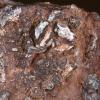 Can you guess what kind of fossil this is? Hint: the light-colored fragments in the specimens are many pieces of chopped-up bone. Although this may not look like much, careful study by CU scientists who examined the fragmented bone contents, chemical composition, and geological context of the specimen, it was concluded that the only way that this mineralized bone-filled mass could have formed in the ancient environment was through the fossilization of carnivore feces. AKA coprolites—this one was likely produced by a large carnivorous dinosaur around 140 million years ago.
Can you guess what kind of fossil this is? Hint: the light-colored fragments in the specimens are many pieces of chopped-up bone. Although this may not look like much, careful study by CU scientists who examined the fragmented bone contents, chemical composition, and geological context of the specimen, it was concluded that the only way that this mineralized bone-filled mass could have formed in the ancient environment was through the fossilization of carnivore feces. AKA coprolites—this one was likely produced by a large carnivorous dinosaur around 140 million years ago.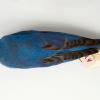 A charismatic species associated with high elevations, this mountain bluebird specimen was collected in Colorado Springs in 1898 (that’s 123 years ago!). Male mountain bluebirds are cloaked in a striking
A charismatic species associated with high elevations, this mountain bluebird specimen was collected in Colorado Springs in 1898 (that’s 123 years ago!). Male mountain bluebirds are cloaked in a striking In 2019 Jen Shannon, CU Museum’s Curator of Cultural Anthropology, commissioned a replica of a Navajo First Phase Chief's Blanket for the collection—a modern artwork that was created using traditional materials (Churro wool and indigo), equipment and techniques.
In 2019 Jen Shannon, CU Museum’s Curator of Cultural Anthropology, commissioned a replica of a Navajo First Phase Chief's Blanket for the collection—a modern artwork that was created using traditional materials (Churro wool and indigo), equipment and techniques.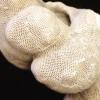 Each hole you see in this image at one point housed a miniature animal. Together, these tiny animals created a netlike colony: the bryozoan. While this image displays an encrusted fossil from the Pleistocene (2.58 million to 11.7 thousand years ago), there are many bryozoan varieties alive today, their habitats ranging from the shallow reefs of the tropics to the frigid waters of the poles.
Each hole you see in this image at one point housed a miniature animal. Together, these tiny animals created a netlike colony: the bryozoan. While this image displays an encrusted fossil from the Pleistocene (2.58 million to 11.7 thousand years ago), there are many bryozoan varieties alive today, their habitats ranging from the shallow reefs of the tropics to the frigid waters of the poles.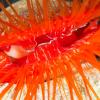 This saltwater bivalve goes by quite a few names including “electro-flame scallop,” “electric clam,” and “disco clam” and it’s easy to see why. These animals are vibrantly colored and are among only a couple bivalves that can display a light show. Disco clams light up—flashing “lights” along their red mantle to confuse and deter predators.
This saltwater bivalve goes by quite a few names including “electro-flame scallop,” “electric clam,” and “disco clam” and it’s easy to see why. These animals are vibrantly colored and are among only a couple bivalves that can display a light show. Disco clams light up—flashing “lights” along their red mantle to confuse and deter predators.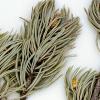 Piñon Pine (Pinus edulis) is a relatively small tree found on dry slopes and mesas at lower elevations (4,500-9,000’) of southwestern North America. In Colorado, this pine most often populates the canyon country of the Western Slope and in the oak-shrub zone of the southern mountains and plains. Amazingly, this tree can live up to 1,000 years, making it a fixture in high desert landscapes.
Piñon Pine (Pinus edulis) is a relatively small tree found on dry slopes and mesas at lower elevations (4,500-9,000’) of southwestern North America. In Colorado, this pine most often populates the canyon country of the Western Slope and in the oak-shrub zone of the southern mountains and plains. Amazingly, this tree can live up to 1,000 years, making it a fixture in high desert landscapes.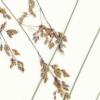 Sweetgrass is a perennial grass with hollow stems and underground rhizomes. It has a purple, red, and white hairless base and can grow to about 30 inches tall. Sweetgrass flowers early for a grass—from May to July. The pressed specimen here was collected in July at the end of the bloom when the flowers were drying.
Sweetgrass is a perennial grass with hollow stems and underground rhizomes. It has a purple, red, and white hairless base and can grow to about 30 inches tall. Sweetgrass flowers early for a grass—from May to July. The pressed specimen here was collected in July at the end of the bloom when the flowers were drying.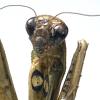 Of the seven species of mantises in Colorado, Mantis religiosa, is one of the largest and most common. They measure up to three inches long and range in color from tan to a bright green, which helps them camouflage from predators. These insects are most recognizable by their triangular-shaped head and “pious” posture with their raptorial first set of arms. At rest, this species will sit, with their front arms folded making it appear as though they are praying, earning their species name religiosa.
Of the seven species of mantises in Colorado, Mantis religiosa, is one of the largest and most common. They measure up to three inches long and range in color from tan to a bright green, which helps them camouflage from predators. These insects are most recognizable by their triangular-shaped head and “pious” posture with their raptorial first set of arms. At rest, this species will sit, with their front arms folded making it appear as though they are praying, earning their species name religiosa.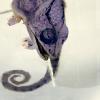 The common chameleon is an arboreal lizard with a range that circumscribes the Mediterranean Sea, occurring in North Africa, the Middle East and extending into Greece, Crete, and southern Spain and Portugal. A charismatic animal, the chameleon is known by its prehensile tail, independently moving eyes, coiled tongue and ability to change colors. Together these traits interact to equip chameleons with extraordinary hunting prowess and social communication tools.
The common chameleon is an arboreal lizard with a range that circumscribes the Mediterranean Sea, occurring in North Africa, the Middle East and extending into Greece, Crete, and southern Spain and Portugal. A charismatic animal, the chameleon is known by its prehensile tail, independently moving eyes, coiled tongue and ability to change colors. Together these traits interact to equip chameleons with extraordinary hunting prowess and social communication tools.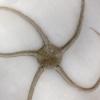 Ophiodia peloria, commonly known as Brittle Star are omnivorous, scavengers and detrivores, (meaning they eat dead and decaying things off the sea floor). Their mouth, which is located on the bottom side of their disc-shaped body is used to both ingest food and expel waste products. These animals eat by pushing their stomachs out of their mouth, pressing it against the food source, then retracting it with its contents back into the body. In short, the one opening acts as mouth and anus.
Ophiodia peloria, commonly known as Brittle Star are omnivorous, scavengers and detrivores, (meaning they eat dead and decaying things off the sea floor). Their mouth, which is located on the bottom side of their disc-shaped body is used to both ingest food and expel waste products. These animals eat by pushing their stomachs out of their mouth, pressing it against the food source, then retracting it with its contents back into the body. In short, the one opening acts as mouth and anus.

